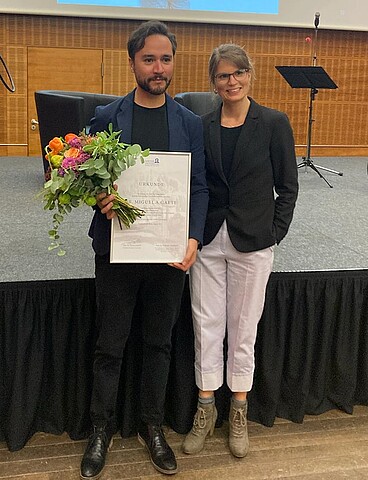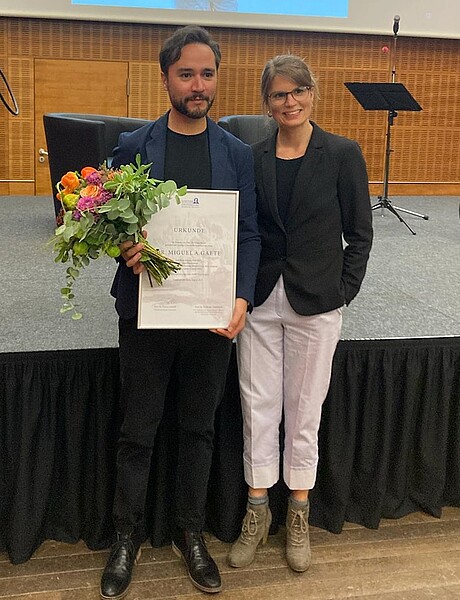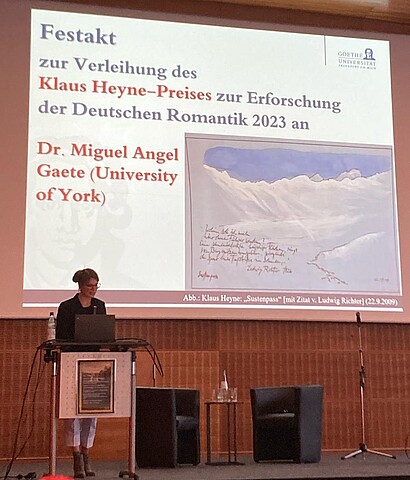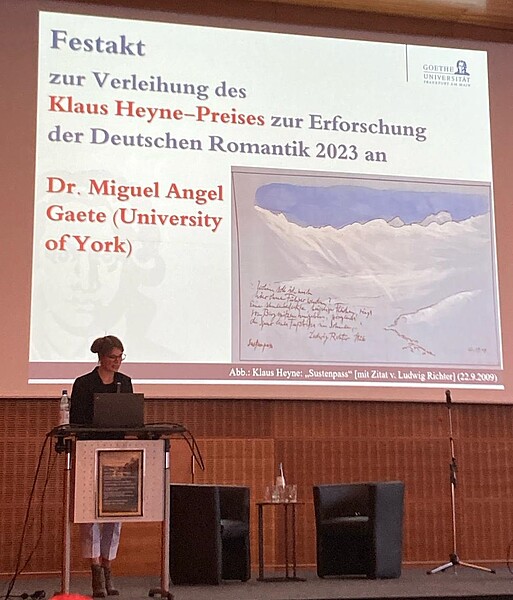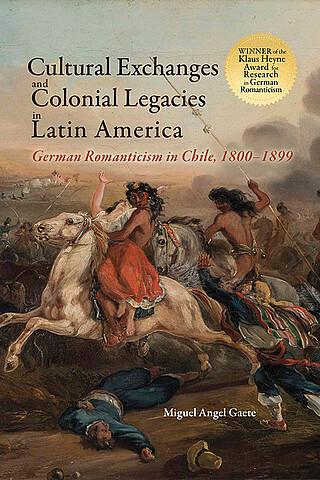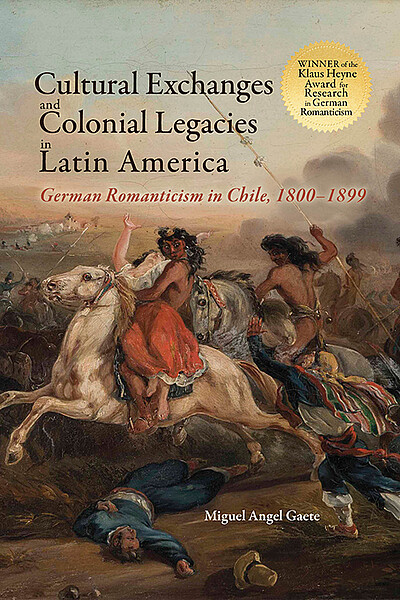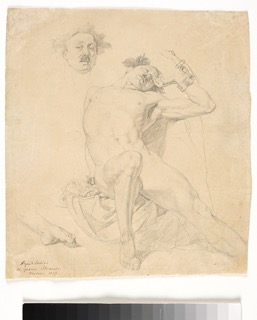Der Klaus-Heyne-Preis zur Erforschung der Deutschen Romantik 2023 geht an den Kunsthistoriker Miguel Gaete
Am 11. Oktober wurde an der Goethe-Universität Frankfurt zum zweiten Mal der Klaus-Heyne-Preis vergeben. Mit seiner Dissertationsschrift „Depicting Terra Incognita. German Romanticism, Arts, Sciences, and the Colonial Gaze in Chile, 1800–1899“ überzeugte der Kunsthistoriker und Philosoph Miguel Gaete (University of York, UK) das Auswahlgremium.
Der Preis, der nach dem Kinderarzt und Romantikliebhaber Prof. Dr. Klaus Heyne (1937–2017) benannt ist und aus dessen Nachlass finanziert wird, fördert Wissenschaftsprojekte zur Erforschung der Romantik und ist mit 15.000 Euro dotiert. Zwei Drittel des Preisgelds stehen für die Konzeption und Ausrichtung einer internationalen Tagung an der Goethe-Universität Frankfurt zur Verfügung, die zur Vertiefung der Grundlagenforschung dienen soll.
Gaete untersucht in seiner kunsthistorischen Arbeit Werke von sechs nichtkanonischen deutschen Künstlern, die im 19. Jahrhundert nach Südamerika reisten und die dortigen Kolonien besuchten. Vor Ort porträtierten die Maler Menschen der indigenen Bevölkerung, fertigten Landschaften sowie Studien von lokalen Pflanzen und Tieren an. Gaetes Arbeit verdeutlicht, dass diese Werke nicht nur Einflüsse von Alexander von Humboldts Amerikabildern zeigen, sondern vor allem mit zeitgenössischen Theorien von ‚Rasse‘ und ‚Volk‘ verflochten sind und somit Zeugnisse westlicher Hegemonie und kolonialen Anspruchs.
Ausgezeichnet wird Miguel Gaetes Dissertation vor allem wegen seiner akribischen Bildanalysen unter Berücksichtigung postkolonialer Gesichtspunkte, die einen dunklen Fleck der deutschen Romantik beleuchten, der in der Forschung bisher wenig aufgearbeitet wurde. Seine Arbeit erschien im Dezember 2023 als Publikation unter dem Titel Cultural Exchanges and Colonial Legacies in Latin America. German Romanticism in Chile, 1800–1899 im Verlag Cambria Press, New York.
Die feierliche Preisverleihung fand im Casino-Festsaal der Goethe-Universität Frankfurt statt und wurde durch Prof. Dr. Frederike Middelhoff eröffnet. Auch Prof. Dr. Katharina Hartmann, Prodekanin des Fachbereichs für Neuere Philologien an der Universität Frankfurt, richtete per Zoom ihre Glückwünsche an den Preisträger und betonte die Bedeutung seiner Arbeit für die Universität. Im Anschluss zeichnete der Kunsthändler Dr. Aurelio Fichter die Genese des Klaus-Heyne-Preises nach, bevor der Preisträger im Gespräch mit Frederike Middelhoff die Kernargumente sowie Ausblicke seiner Forschung im Rahmen einer Podiumsdiskussion vorstellte. Den Abschluss des Abends stellte der eindrucksvolle wissenschaftliche Festvortrag „Der Malerroman als Entwurf einer romantischen Poetik“ von Prof. Dr. Monika Schmitz-Emans (Ruhr-Universität-Bochum) dar.
Durch die folgenden Ausführungen und Antworten auf drei Fragen, gibt der Preisträger Einblick in seine Arbeit und Forschung:
1. How did you navigate the phenomenon of ‘Romanticism’ in your award-winning dissertation?
In my dissertation, I approached Romanticism critically, emphasising aspects often overlooked in Romanticism studies. I delved into the roles of sciences, race, and colonialism in the works of Romantic artists and naturalists who ventured beyond Europe in the 19th century.
Addressing this issue from a de-romanticised perspective, I explored the contributions of six relatively unknown figures within the German Romantic movement: Otto Grashof, Theodor Ohlsen, Carl Alexander Simon, Eduard Poeppig, Rudolph Amandus Philippi, and Johann Moritz Rugendas. These artists and naturalists journeyed to Chile during the 19th century to portray Indigenous people, nature, and landscapes. Their presence in South America was significantly influenced by the German colony established in Chile in the mid-19th century. I argue that the texts and images resulting from their journeys were not mere outcomes of artistic practices alone but fundamental components of colonial operations and wider underlying Western interests in the region.
2. In what areas do you still perceive gaps in art historical research on Romanticism?
Regarding gaps in art historical research on Romanticism, there are avenues yet to be thoroughly explored, particularly concerning the specific impact of Romantic ideals on colonial art and visual culture. The intercontinental connections between Romanticism in Europe and its manifestation in distant regions offer a rich field for further inquiry. Additionally, an in-depth exploration of the representation of Indigenous cultures within the Romantic framework remains a notable gap in existing scholarship. Furthermore, the study of Romanticism remains surprisingly confined to a limited number of artists. In effect, we see repeatedly the same artists being discussed in conferences and literature. In this regard, much more archival and empirical research has to be conducted in order to bring to the fore the myriad of Romantic artists overseas who remained widely ignored.
3. Could you elaborate on potential links to further research into Romanticism that stem from your dissertation project?
My dissertation project opens doors to further research on Romanticism by highlighting the need for a more comprehensive understanding of its influence on the visual culture and society beyond Europe and even beyond the arts. One crucial argument of my work is that Romantic aesthetic categories such as the picturesque and the sublime experienced noticeable alterations when deployed overseas. Thus, we cannot study these topics as simple readaptations carried out in different geographical settings. The complexity of this phenomenon requires new theoretical frameworks, I believe.
On this matter, a very exciting project I am starting to work on considers how Romanticism might have influenced the ideological foundation of German colonies across Latin America. During the 19th and mid-20th centuries, several German settlements were established in Brazil, Argentina, Paraguay and Chile, all driven by similar Romantic ideals of nationhood, race, nature, and power. This new project represents the first systematic exploration of visual materials and cultural artefacts generated within five German colonies in Latin America: Lake Llanquihue, „Colonia Dignidad“ (Chile), Pomerode (Brazil), „Nueva Germania“ (Paraguay), and Bariloche (Argentina). Through a multidisciplinary approach, I seek to uncover the intricate narrative of these colonies’ formation and evolution, illuminating how Romantic ideals shaped social interactions and cultural expressions and their impact on the natural environment and local Indigenous communities. My hypothesis is that German colonies in Latin America represent an overlooked yet essential by-product of German Romanticism. In addition, because of their enclosed and restricted nature, I propose to examine German settlements as cultural objects akin to paintings or sculptures.
